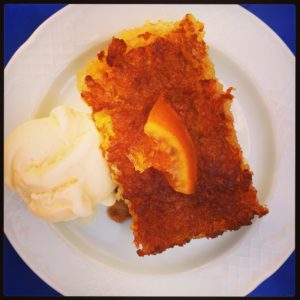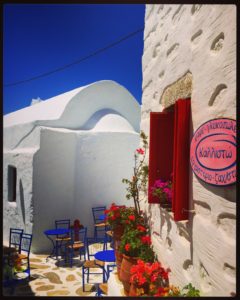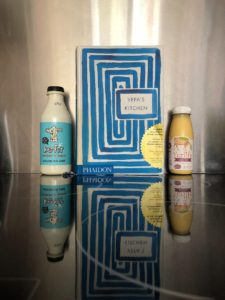Recipe: Alex’s portokalopita (orange pie)

Amorgos is one of the Greek islands I’ve recently visited, as well as one of my favorites. Hora, the capital of the island, welcomed me with a palette of colors: blushing bougainvillaeas climbing the walls of white-washed houses and blue-domed churches and chapels, with their doors and window shutters painted blue, red or green, matching the chairs and tables scattered around the cobblestone alleys. Lost in the snarl of these very alleys, I came across Kallisto, an inviting little café-patisserie. I had a slice of portokalopita (orange pie), which was indulgently served with vanilla ice-cream.

Returning home, I set to re-create Kallisto’s portokalopita. A quick Google search brought me across a number of slightly different recipes and one question: which one should I choose? Some used Greek yogurt, others milk or cream; the number of eggs varied between three and five and so did the number of oranges. Despite their differences, however, there was one thing that all these recipes had in common: they all used filo pastry.
I managed to narrow it down to three recipes, all by chefs that I know and trust:
- Argiro Barbarigou was the only chef who used marmalade in her recipe (I believe the recipe is available only in Greek).
- In his version (Orange Phyllo Cake with Syrup), Akis Petretzikis, boiled the oranges for a couple of hours. He claimed to have tried over 20 different recipes before sharing his own. Yet, this version was by far the most complicated of the ones I came across.
- In her recipe book ‘Vefa’s Kitchen’, Vefa Alexiadou, uses a version that appeared rather similar to the other ones I found online (my guess is that they were largely based on Vefa’s rather than the other way round).
At the end, I decided to go for Vefa’s recipe, but with two small tweaks; I swapped the sugar with honey, and the yogurt with kefir. I was first introduced to this fermented milk drink a few years ago, while on holidays (also) in Greece. Kefir is not only rich in nutrients, such as protein, calcium and vitamins, but it also contains probiotics. These live micro-organisms (bacteria and yeasts), often described as ‘good’ or ‘friendly’ bacteria, can have various health benefits. For example, they may help sufferers with indigestion, IBS (Irritable Bowel Syndrome) and lactose intolerance. Since kefir has recently become widely available in the UK, I’ve started using it in my recipes as a substitute for yogurt or even milk.

The end result was as fragrant and moist as Kallisto’s. and it took me back to Amorgos. My colleagues also enjoyed it to the extent that I had to later hand out copies of the recipe. And, here it is:
Alex’s portokalopita (orange pie):
Ingredients:
- 175 ml kefir
- 2 packs of ready rolled filo pastry (approx. 450 grams)
- 3 oranges
- 4 eggs
- 250 ml Greek olive oil
- 1 cup (350 grams) honey for the syrup, and 1/4 cup (75 grams) honey for the main mixture
- 2 teaspoons vanilla extract
- 2 tablespoons baking powder
- Melted butter, for brushing
Method:
- Let the filo pastry dry (preferably overnight).
- Once they are dry, cut them into small pieces.
- Squeeze and grate the zest of the oranges.
- Beat together half of the zest, the eggs, the olive oil, 1/4 cup (75 grams) honey and the vanilla extract.
- Mix the baking powder in the kefir, and stir into the egg mixture.
- Stir the filo pieces into the egg mixture.
- Brush a 25 x 30 cm baking pan with melted butter
- Preheat the oven to 180 C (160 C fan).
- Transfer the mixture into the baking pan.
- Bake for 35 minutes, or until golden.
- Meanwhile, make the syrup. In a pan, add the squeezed orange juice, the remaining half of the zest, and the remaining honey (350 grams). Bring to the boil, stirring along. Then, simmer for 5 minutes and, then, remove from the heat.
- Pour the syrup over the pie, and let it stand for a couple of hours, before serving.
Enjoy it with vanilla ice-cream!
Kali Orexi! Bon Appétit!
Alex
(the Traveling Psychiatrist)
Further reading
To read my tips about Amorgos, read my post.
For more tips about Amorgos and other Greek islands, read the Guardian readers’ travel tips.
Featuring hundreds of recipes from all over Greece, Vefa Alexiadou’s Greece: The Cookbook is simply the bible of Greek cuisine. This is the newer edition of ‘Vefa’s Kitchen’.
If, like me, you have a sweet tooth, check out Vefa’s Greek Pastries and Desserts
Akis Petretzikis’ recipes are simple to make yet delicious to taste. His excellent website features hundreds of recipes and videos too.
Last but not least, to follow my travels around the world, simply subscribe to the Traveling Psychiatrist (just click on the menu on the left hand side).
One Comment
Fofi Noutsou
♡♡♡